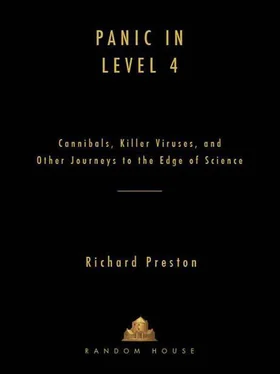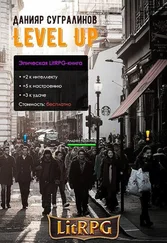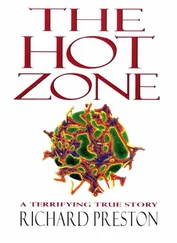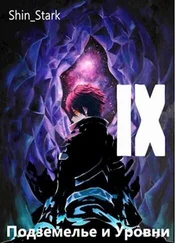It See Home Depot thing.
J. Craig Venter InstituteA nonprofit institute dedicated to research in genomics, founded and run by genomic scientist J. Craig Venter.
Lesch-Nyhan syndromeA rare genetic disease, almost invariably expressed in males, in which the patient engages in compulsive acts of self-injury. It was first characterized in 1962 by medical researcher William L. Nyhan and medical student Michael Lesch at Johns Hopkins Hospital in Baltimore.
Ludolphian number, theThe same number as pi(p). The name is derived from Ludolph van Ceulen, a German mathematician of the seventeenth century who approximated pi to thirty-five decimal places and had the digits engraved on his tombstone.
m zeroA powerful supercomputer constructed largely of mail-order parts by the mathematicians David and Gregory Chudnovsky. Predecessor to the Home Depot thing.
MbwambalaA patch of disturbed woodland about three miles long and half a mile wide that wanders along a stream about six miles southeast of the city of Kikwit, Democratic Republic of the Congo.
National Institutes of Health (NIH)A federally funded collection of medical research institutes situated on a campus in Bethesda, Maryland, that both conducts and funds many billions of dollars in medical research every year.
nucleotideAn information-carrying building block, or “letter,” of DNA. There are four nucleotides in DNA: adenine, thymine, cytosine, and guanine; they are designated by the letters A, T, C, and G.
number theoryThe mathematical study of the properties of numbers.
parasiteAn organism that lives on or inside another organism, its host,and feeds on the host, being harmful to the host or of no benefit to it.
pi (π)The ratio of the circumference of a circle to its diameter. Expressed in decimals, pi goes 3.14159…and continues infinitely, without periodically repeating. Pi is a transcendental number.
pubic symphysisAn area in the lower front of the pelvis where the pelvic bones join in a suture filled with cartilage.
red diarrhea, theThe local Congolese term for an Ebola virus infection during the 1995 outbreak in Kikwit, Congo.
self-mutilation, compulsiveUncontrollable physical self-injury, such as self-biting. In Lesch-Nyhan syndromeit arises ultimately from a defect in the gene that codes for the HPRTprotein, though the exact mechanism of the disease is unknown.
strebelid fliesParasitic wingless flies that crawl and live on bats. A conjectured possible natural host of the Ebola virus.
supercomputerOne of the world’s most powerful computers for its time.
TIGRThe Institute for Genomic Research, a nonprofit research institute dedicated to sequencing genomes,now part of the J. Craig Venter Institutein Rockville, Maryland.
transcendental numberA number that is not the exact solution to any polynomial equation that has a finite number of terms with integer coefficients. See pi.
tubular cast, throwing aExpelling through the anus a sleevelike lining of the intestines and rectum.
Unicorn Tapestries, theSeven tapestries of large size and exceptional preservation and beauty (though one of them is now in fragments), originally woven around 1500 in Brussels or Liège, now hanging in the Cloisters Museum in New York City. The Unicorn Tapestries are considered to be among the great works of art of all time.
virusA disease-causing agent smaller than a bacterium consisting of a shell made of proteins and membranes and a core containing DNA or RNA. A virus is a parasite that can replicate only inside living cells, using the machinery of the cell to make more copies of itself.
warp, weftStrong, straight noncolored threads (warp threads) and delicate undulating colored threads (weft threads) are woven to form a tapestry. In many late medieval tapestries, including the Unicorn Tapestries,the warp threads run horizontally and the weft threads run vertically.
wet labAn underground room at the New York Metropolitan Museum of Art where tapestries and works of fabric art are washed, conserved, and photographed.
Zarate procedureA surgical procedure whereby the bones of the pelvis are cut in front, at the location of the pubic symphysis,the cut running through a suture of cartilage there. It causes the pelvis to spring open. The Zarate procedure is a crude but effective way of releasing a baby stuck in the birth canal.
The principal thanks in this book must be given to the people who are portrayed in it. They often patiently and generously submittted to the sort of tedious questioning that I gave Nancy Jaax when I examined her hands. I’m especially grateful to: Nancy Jaax; “Jeremy” “Martha” Gregory and Christine Chudnovsky; David Chudnovsky and Nicole Lannegrace; the late Malka Benjaminovna Chudnovsky; the late Herbert Robbins; Richard Askey; William T. Close; Will Blozan; Heidi Blozan; Rusty Rhea; Kristine Johnson; Tom Remaley; Tim Tigner; Lee Frelich; Carolyn Mahan; Richard Evans; James Åkerson; Christopher Asaro; Stephen C. Sillett; D. Scott Sillett; Robert Van Pelt; J. Craig Venter; Claire Fraser; Hamilton O. Smith; Marshall R. Peterson; James D. Watson; Eric S. Lander; Norton Zinder; Francis Collins; Gene Meyers; Jeffrey and Tondra Lynford; Morton H. Meyerson; Tom Morgan; Peter Barnet; Barbara Bridgers; Scott Geffert; Joseph Coscia, Jr.; Oi-Cheong Lee; Timothy Husband; William L. Nyhan; Michael Lesch; Nancy Esterly; James Elrod; James Elrod’s sister; the late and beloved Jim Murphy; all the members of the Murphy family I met, who gave so generously of their time and thought; Andy Pereira; Steve Glenn; Tracye Overby; Michael Roth; Christopher Reeves; Brad Alerich; H. A. Jinnah; Takaomi Taira; Philippe Coubes.
Many thanks to Tim Bartlett, my editor at Random House, who is the overall editor of this book. Many thanks also to Tina Bennett and Lynn Nesbit at Janklow & Nesbit Associates. At The New Yorker, past and present, I’m grateful to the following people for their contributions to various parts of this book: Robert Gottlieb, Tina Brown, David Remnick, John Bennet, Sharon DeLano, Dorothy Wickenden, Amy Davidson, Peter Canby, Martin Baron, Ann Goldstein, Elisabeth Biondi, Elizabeth Culbert, and the late Miss Eleanor Gould (Eleanor Packard); while the following checkers worked on certain parts: Hal Espen (“The Mountains of Pi”); Christopher Jennings and Michael Peed (“A Death in the Forest”); Bill Vourvoulias and Daniel Hurewitz (“The Search for Ebola”); Andy Young (“The Human Kabbalah”); Marina Harss (“The Lost Unicorn”); and Lila Byock and Jessica Rosenberg (“The Self-Cannibals”). Any errors of fact in this book are my responsibility, though where I got things right, very often a checker was involved.
My wife, Michelle, and our children, Marguerite, Laura, and Oliver, with their endless curiosity and openness to new things, inspired this book. They were also present for some of the interviews in “The Lost Unicorn,” and they have had their own friendship with the Chudnovsky family and asked their own questions. Michelle, who worked as a checker at The New Yorker, inspired me in fact-checking. She continues to inspire me in far greater ways than that.
Читать дальше








![Shin_Stark - В подземелье я пойду, там свой level подниму X [СИ]](/books/384602/shin-stark-v-podzemele-ya-pojdu-tam-svoj-level-po-thumb.webp)



